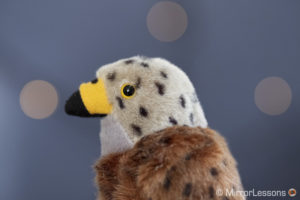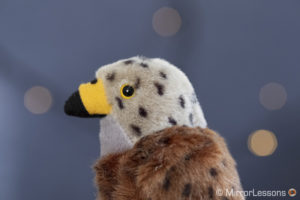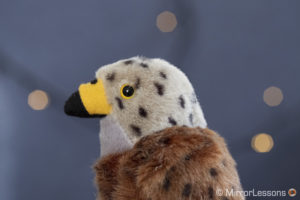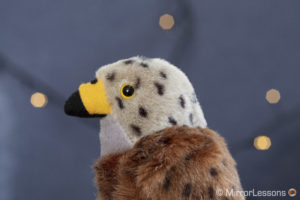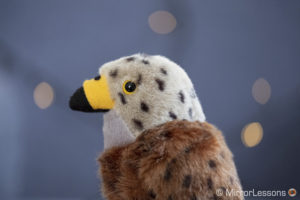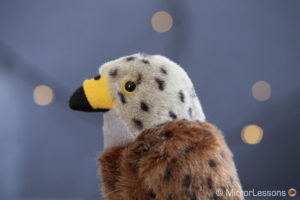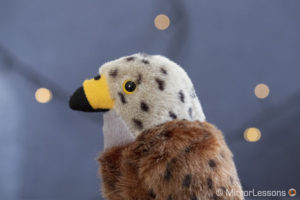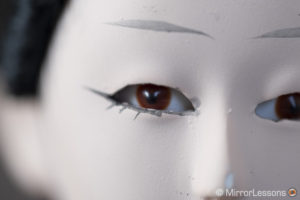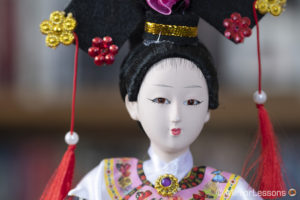If you are a photographer whose affection is torn between portraits and macro, I can bet you’ve asked yourself at some point: does it make more sense to use a single macro lens for both portraits and macro work, or invest in a dedicated portrait lens?
On one hand, macro lenses make great portrait lens substitutes. Not only do they render lots of sharp details but they also tend to offer similar focal lengths to those considered ideal for portrait work.
On the flip side however, they tend to have a slower maximum aperture than most portrait glass – f/2.8 at the very brightest – and sometimes that extreme detail rendering can reveal too many imperfections on a person’s face.
With these considerations in mind, it’s time to take a look at how Fujifilm’s latest macro prime, the XF 80mm f/2.8, stands up against one of its best telephoto portrait offerings, the XF 90mm f/2, with a specific focus on their characteristics for portrait work.
Ethics statement: We were loaned these two XF lenses for review purposes. We were not asked to write anything about the lenses, nor were we provided with any sort of compensation. Within the article, there are affiliate links. If you buy something after clicking the link, we will receive a small commission. To know more about our ethics, you can visit our full disclosure page. Thank you!
[toc heading_levels=”2,3″]
Main Specifications
Fujinon XF 80mm f/2.8
- Mount: X-mount
- Format coverage: APS-C
- Focal length: 80mm
- Focal length (equiv. 35mm): 122mm
- Maximum aperture: 2.8
- Minimum aperture: 22
- Number of aperture blades: 9 circular blades
- Angle of view: 20.1°
- Closest focusing distance: 25cm
- Lens configuration: 16 elements / 12 groups
- Special elements: 1 aspherical, 3 ED elements, 1 Super ED element
- Lens surface coating: Yes (Super-EBC)
- Maximum image magnification: 1x
- Optical Image Stabiliser: Yes
- Dimensions: ø80mm x 130mm
- Filter diamater: 62mm
- Weight: 750g (excluding lens cap, lens rear cap, lens hood)
Fujinon XF 90mm f/2 R LM WR
- Mount: X-mount
- Format coverage: APS-C
- Focal length: 90mm
- Focal length (equiv. 35mm): 137mm
- Maximum aperture: 2
- Minimum aperture: 16
- Number of aperture blades: 7 rounded blades
- Angle of view: 17.9°
- Closest focusing distance: 60cm
- Lens configuration: 11 elements / 8 groups
- Special elements: 3 extra low dispersion elements
- Lens surface coating: Yes (Super-EBC)
- Maximum image magnification: 0.2x
- Optical Image Stabilizer: No
- Dimensions: ø75mm x 105mm
- Filter diamater: 62mm
- Weight: 540g (excluding lens cap, lens rear cap, lens hood)
Design and ease of use
Physically speaking, the 80mm looks like a taller, wider and heavier version of the 90mm, with nearly all the same characteristics such as a black metallic barrel occupied by a large ribbed focus ring and a clicking aperture ring that moves in 1/3 steps.

The only real difference in the focus rings is that the 80mm’s is rubberised while the 90mm’s is metallic. Personally I prefer the rubber version as it is grippier and isn’t as cold to the touch.
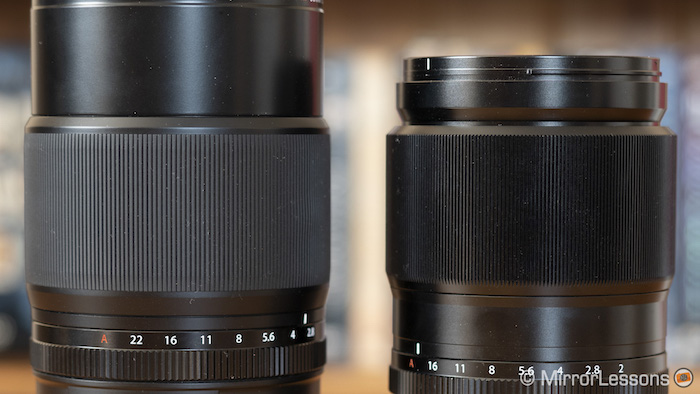
Two extra features found on the barrel of the 80mm are the focus limiter switch and an on/off switch for optical stabilisation. The former lets you choose between three focus ranges: Full, 50cm to infinity, and 25cm to 50cm.
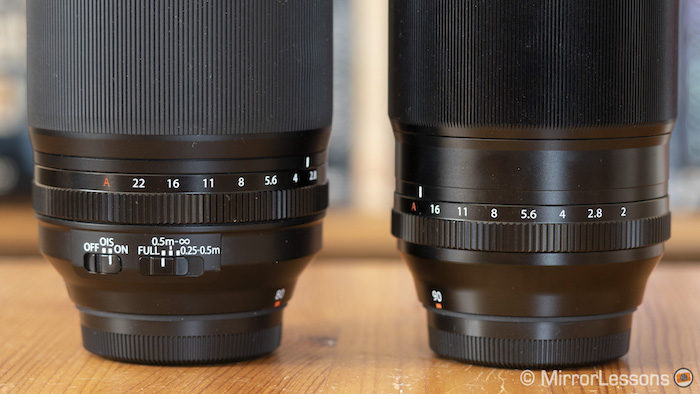
The two lenses have the same filter diameter but the 80mm, being a larger lens, also comes with a larger lens hood. Both hoods are made of plastic and are cylindrical in shape.
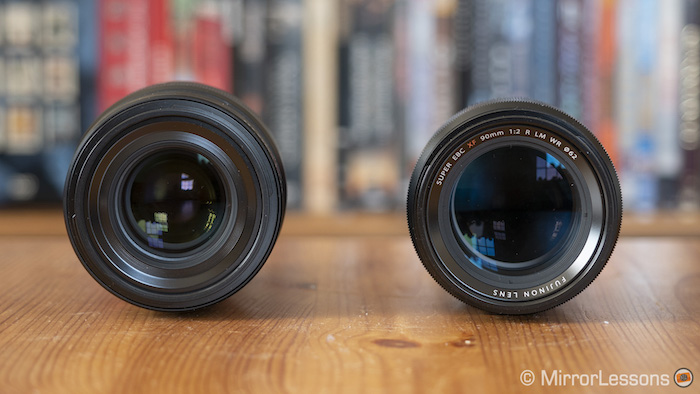
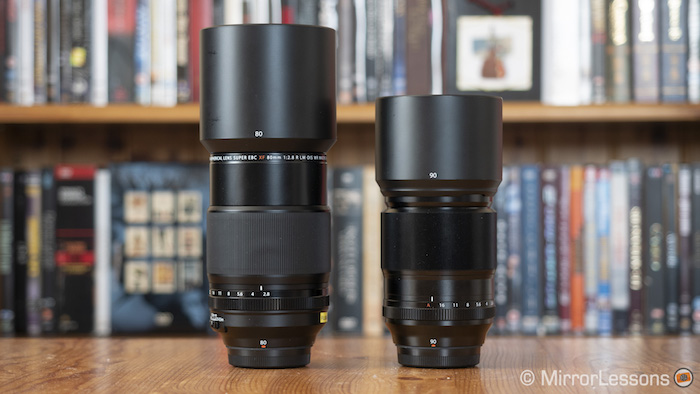
Because the 80mm is fairly large and heavy, it best suits high-end models like the X-T2, X-Pro2 and X-H1. The 90mm is somewhat smaller and lighter, so you have a bit more flexibility in terms of the cameras you can comfortably use it on.
One final thing to note is that when the camera is turned off or the lenses are unmounted, you will be able to feel and hear the floating lens elements moving inside if you move the lenses around. Don’t worry, this is perfectly normal! There are magnets linked to the AF motor that cease to be engaged when the power is turned off, meaning they no longer hold the linear motor in place. Attach the lens, turn the camera on and you will notice that they no longer move.
Characteristics and optical quality
Field of view
Focal length can be a major factor when choosing between lenses, though in the case of the 80mm and 90mm, the difference isn’t that big at all.
Below you can see an example that shows the difference in composition when shooting from the same distance. You will have the chance to see other examples in the sharpness and bokeh chapters.
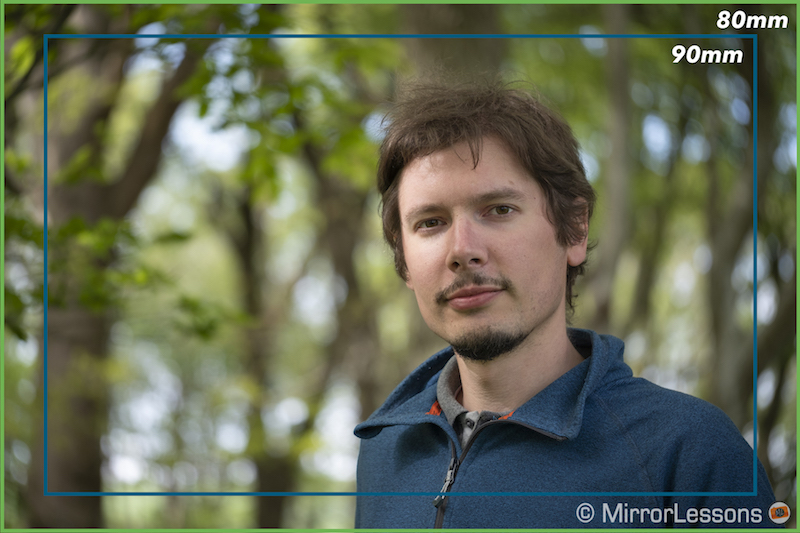
In 35mm format (full frame) terms, the 80mm gives you approximately the same field of view as a 120mm whereas the 90mm is closer to a 135mm lens.
Sharpness
Let’s begin with how the two lenses perform in terms of sharpness at a close distance. To make the side by side images easier to compare, I tried to create the same composition by moving the tripod back slightly while using the 90mm.
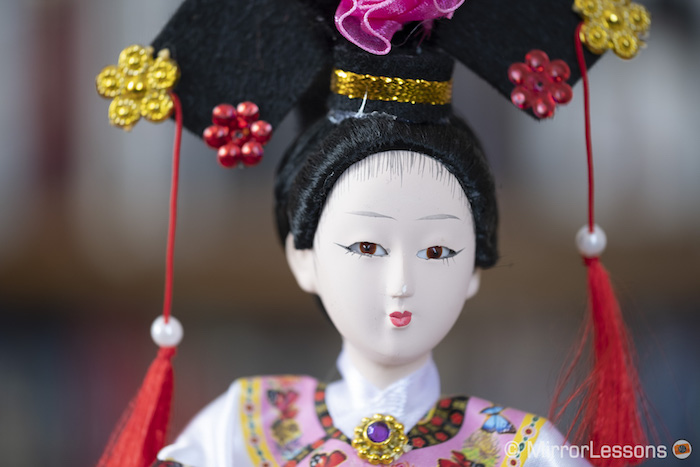
At their fastest apertures – f/2 on the 90mm and f/2.8 on the 80mm – the 80mm is much more capable of rendering fine details, which could only be expected from a macro lens. Sharpness from the 90mm is still very acceptable though, especially if we take into account the one-stop difference in aperture.
The 80mm continues to be sharper than the 90mm even at f/2.8 and f/4 but the differences are definitely more subtle at f/4.
By f/5.6, the 90mm catches up with the 80mm, making it very difficult to tell the difference between the two.
However at f/8 and f/11, the 90mm once again loses ground to the 80mm, albeit by a very small amount.
By f/16, both lenses produce visibly softer results due to diffraction but the 80mm does seem to retain a small lead over the 90mm. f/22 is so soft on the 80mm that I don’t really consider it useable.
Peak performance occurs at around f/4 on the 80mm at this distance, though f/5.6 and f/8 aren’t far off at all. With the 90mm, the best results are found at f/5.6.
Since telephoto lenses can also be used for sports and landscape work, let’s take a look at how they perform at a longer distance as well. Keep in mind that the 90mm examples are more magnified than those from the 80mm because I took them from the exact same spot.
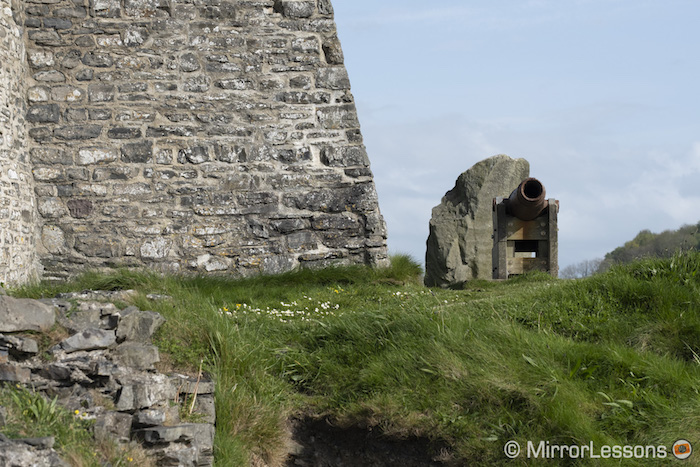
At this distance, it is actually the 90mm that appears to outperform the 80mm, particularly at the fastest apertures (including f/2).
By f/5.6, the two lenses look quite similar once again and this trend continues up until f/16. The only exception is f/11 at which the 90mm looks ever so slightly sharper.
In the case of the 90mm, peak performance is found at around f/4 but f/2.8 and f/5.6 are extremely close. The 80mm delivers the best results between f/4 and f/8 by contrast.
Happily both lenses deliver good results in the corners as well. The 90mm is sharper overall as you can see from the examples taken at f/5.6 so it’s a more viable option for telephoto landscape work.
But what about portraits? Well, we’re happy to report that both lenses deliver excellent results at f/2 (90mm) and f/2.8 (both lenses) and in terms of sharpness, actually look very similar. This can be seen in the eye crops below which were taken from a headshot.
Depth of field
Three key selling points of any portrait lens are bokeh, shallow depth of field and subject separation. In the case of the 80mm and 90mm, we must also consider the difference in focal length and maximum aperture. Let’s take a look at how they behave.
Starting with two portraits taken at the same distance and the fastest apertures, we can see that both the field of view and amount of background blur are different: the 90mm provides more background blur due to the more compressed perspective and the faster maximum aperture of f/2. The 90mm has larger and rounder bokeh balls, while the 80mm produces a swirly bokeh with “cat’s eye” shapes close to the edge of the frame.


If I set the two lenses to the same aperture of f/2.8, the 90mm continues to provide a shallower depth of field thanks to its longer focal length but the differences are more subtle.

What happens if I change the distance in order to produce a similar composition? Well, as you might have expected, the 90mm continues to produce a smoother background blur when both lenses are set to their respective fastest apertures.
Setting them to the same aperture results in a more similar background blur but the 90mm still produces a more pleasing result than the 80mm.
Bokeh
By looking at all the previous images, you may have started to notice the bokeh characteristics of the two lenses.
The 90mm has a smoother, more uniform rendering overall. The bokeh balls are round across the frame at f/2 and clearly start to assume the shape of the aperture at f/4. There is no sign of onion rings or obvious aberrations which contributes to the creamy effect of the bokeh.
The 80mm, on the other hand, produces very distinct cat’s eye shapes at f/2.8 which become more uniform if you stop down to f/4. At f/4 and f/5.6, you can clearly see the shape of the aperture emerge.
Though it’s more clear in the previous set of examples of Mathieu in the woods, the 80mm consistently produces a swirlier bokeh than the 90mm.
Minimum focus distance
One of the most important differences between these two lenses is how close they are able to focus.
The 80mm offers 1:1 magnification and a minimum focus distance of 25cm, which is a good combination for most macro work, and to some extent portrait work as well if you enjoy homing in on specific features of a person’s face. Below you can see a couple of examples taken with the 80mm at or very close to the minimum focus distance.


The 90mm’s minimum focus distance is a much more modest 60mm with 0.2x magnification. It isn’t any good for macro work but perfectly fulfils the requirements of a portrait lens.
Chromatic aberrations, vignetting, distortion and flare
To be perfectly honest, I didn’t come across any glaring defects during our testing period. It’s testament to the high quality of the latest Fujinon optics, and we can only hope that the trend will continue.
At the fastest aperture of the 90mm, you might come across some very mild chromatic aberration in high contrast areas of the frame but it is barely noticeable.
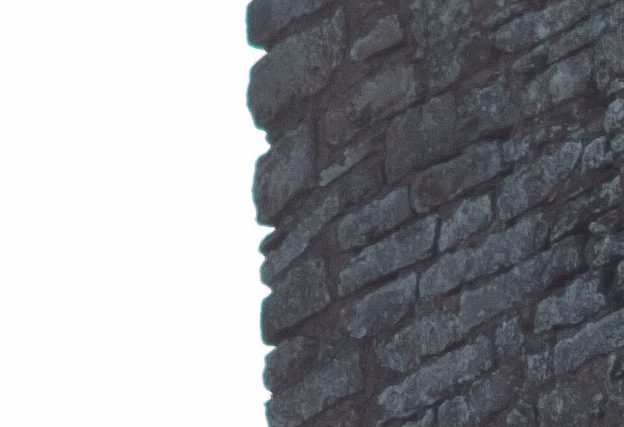
And if anything, I encountered purple sensor flare far more often than actual lens flare.
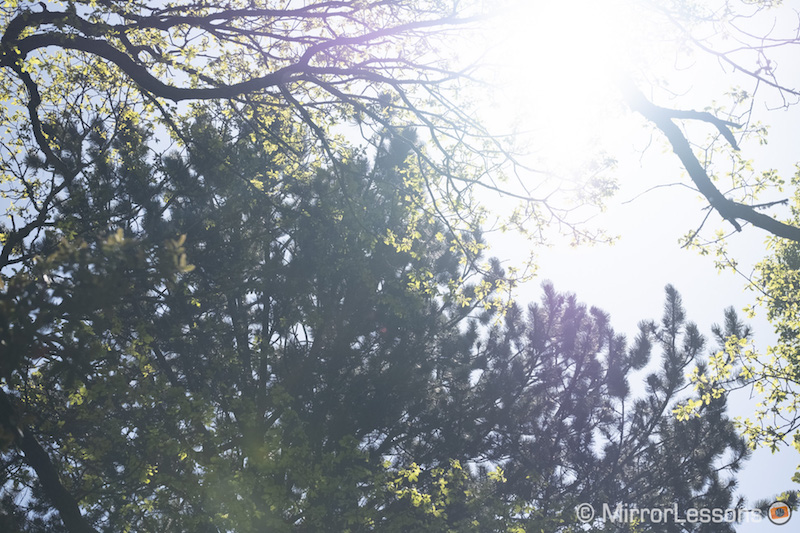
Optical stabilisation
Because the 80mm features built-in optical stabilisation and the 90mm does not, we can’t really draw any comparisons here. Used on the X-T2, we found that it was possible to take in-focus images with the 80mm down to around 1/4 of a second when photographing a subject positioned a meter away.

That said, we strongly advise raising your shutter speed as much as possible when doing macro work since even the slightest micro-movements can blur your image. When we visited our local butterfly house for example, I did manage a couple of shots at 1/15 of a second but generally found it much safer to stay above 1/100 of a second.


Autofocus and manual focus performance
Comparing the two lenses side-by-side on the X-T2, it becomes clear that the XF 90mm is the faster lens when it comes to autofocusing thanks to the quad linear motor. We’ve tested it extensively with moving subjects in both good and low-light conditions many times in the past and have never failed to be impressed by the quick and smooth performance.

The 80mm is naturally slower but you can speed up autofocusing and reduce hunting by taking advantage of the focus limiter switch on the side of the barrel. For example, if you know you’ll only be shooting macro subjects at a close distance, simply switch to “0.25m – 0.5m” so that the camera never tries to focus beyond that range.


The only time the limiter poses a barrier is when you are shooting a subject that moves back and forth between the two ranges, in which case you might be better off switching to the Full range.
When autofocusing, both lenses produce a subtle whirring noise but you soon learn to ignore it.
By contrast, the manual focusing experience on the 80mm is a little better, in part thanks to the rubberised focus ring. That said, I found it quite easy to fine-tune my focus point with either lens.
Conclusion
In an ideal world, very few photographers would buy a macro lens solely for portrait work unless the macro lens in question was the only one in the line-up with a focal length suitable for portraits.
A good example is the XF 60mm f/2.4 macro which, at the launch of the X Series, was the only valid “short telephoto” portrait option until it was later supplanted by the XF 56mm f/1.2 and XF 50mm f/2.
Because the XF 90mm f/2 exists, it only makes sense to buy the XF 80mm f/2.8 for portrait work if your main interest is macro and you’d rather not invest in a separate portrait lens due to budget constraints or because your interest in portraits is casual. Sure, it provides excellent detail rendering and a fairly nice bokeh as we’ve seen from the portrait examples in this article but it doesn’t come close to the creamy, ethereal look of the 90mm.
Indeed, not even common arguments such as price or size can be used in its defence, as the 80mm is approximately $200 more expensive than the 90mm and nearly 200g heavier.
Choose the XF 80mm f/2.8 if you:
- enjoy casual portrait photography but mostly want to shoot macro
Choose the XF 90mm f/2 if you:
- are primarily interested in portrait work
- need a quick telephoto prime for shooting sports and action
Check the price of the XF 80mm f/2.8 on
Amazon | Amazon UK | B&H Photo | eBay
Check the price of the XF 90mm f/2 on
Amazon | Amazon UK | B&H Photo | eBay
You may also like the following lens comparisons:
- Fujifilm 50mm f/2 vs 56mm f/1.2 vs 60mm f/2.4 – Complete comparison
- Fujifilm 56mm f/1.2 vs Samyang 50mm f/1.2 – Complete comparison
- Fujifilm 56mm f/1.2 vs 90mm f/2 – Complete comparison
Additional Images
XF 80mm f/2.8






XF 90mm f/2



























